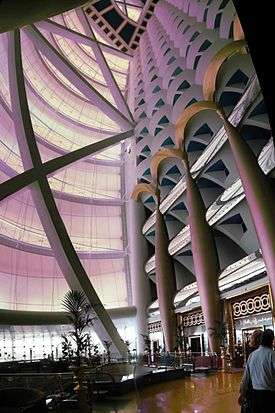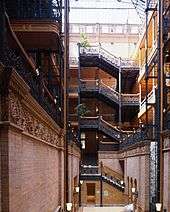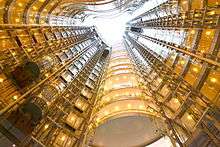Atrium (architecture)



In architecture, an atrium (plural versions: atria in Latin or atriums in American English) is a large open air or skylight covered space surrounded by a building.[1] Atria were a common feature in Ancient Roman dwellings, providing light and ventilation to the interior. Modern atria, as developed in the late 19th and 20th centuries, are often several stories high and having a glazed roof or large windows, and often located immediately beyond the main entrance doors (in the lobby).
Atria are a popular design feature because they give their buildings a "feeling of space and light."[2] The atrium has become a key feature of many buildings in recent years.[3] Atria are popular with building users, building designers and building developers. Users like atria because they create a dynamic and stimulating interior that provides shelter from the external environment while maintaining a visual link with that environment. Designers enjoy the opportunity to create new types of spaces in buildings, and developers see atria as prestigious amenities that can increase commercial value and appeal.[4] Fire control is an important aspect of contemporary atrium design due to criticism that poorly designed atria could allow fire to spread to a building's upper stories more quickly.
Ancient atria

The Latin word atrium referred to the open central court, from which the enclosed rooms led off, in the type of large ancient Roman house known as a domus. The impluvium was the shallow pool sunken into the floor to catch the rainwater. Some surviving examples are beautifully decorated. The opening in the ceiling above the pool called for some means of support for the roof, and it is here where one differentiates between five different styles of atrium. As the centrepiece of the house, the atrium was the most lavishly furnished room. Also, it contained the little chapel to the ancestral spirits (lararium), the household safe (arca) and sometimes a bust of the master of the house.
The term was also used for a variety of spaces in public and religious buildings, mostly forms of arcaded courtyards, larger versions of the domestic spaces. Byzantine churches were often entered through such a space (as are many mosques, though the term is not usually used for Islamic architecture).
19th century: Glazed atrium
The 19th century brought the industrial revolution with great advances in iron and glass manufacturing techniques. Courtyards could then have horizontal glazing overhead, eliminating some of the weather elements from the space and giving birth to the modern atrium.
-

Victoria Hall in Halifax Town Hall, 1863
-

Atrium at the center of the Bradbury Building, 1893, in Los Angeles
Modern-day atriums
One of the main public spaces at Federation Square, in Melbourne, Australia, is called The Atrium and is a street-like space, five storeys high with glazed walls and roof. The structure and glazing pattern follow the system of fractals used to arrange the panels on the rest of the facades at Federation Square.
In Nashville, Tennessee, U.S., the Opryland Hotel (not to be confused with Opryland USA) hosts 4 different large atriums, spanning 9 acres of glass ceiling in total, in the hotel above the gardens of: Delta, Cascades, Garden-Conservaties, and Magnolia.
As of 2016, the Burj Al Arab hotel in Dubai, has the world's tallest atrium at 590ft (180m). The Luxor Hotel, in Las Vegas, Nevada, has the largest atrium in the world (by volume) at 29 million cubic feet (820,000 m³).
Image examples
-

The atrium of 1 Bligh Street, a Sydney office tower, looking upwards
-

Looking up inside the 32-story atrium of the Shanghai Grand Hyatt, part of the Jin Mao Building
-

Atrium of the New York State Theater at Lincoln Center
-

The Tucson High School Galleria and reflexive library (pictured) feature a modern atrium tetrastylum with four support columns and open roof
-
The Grand Piazza atrium inside the SuperStar Virgo
-

Four floor atrium of Gould Hall, College of Architecture and Urban Planning, at the University of Washington
-

The Grand Doubletree hotel/condo in Downtown Miami 42 story atrium
-

Atrium of Complexe Desjardins, Montreal
-

Multi-floor atrium with three see-through octagonal elevator shafts in Water Tower Place in Chicago
-

Main atrium of Piarco International Airport
See also
| Wikimedia Commons has media related to Atriums. |
References
- ↑ "Atrium". The Free Dictionary. Retrieved 8 April 2014.
- ↑ Driscoll, Matt (2013) Model Making for Architects. Ramsbury UK: Crowood Press, p. 69.
- ↑ Steemers, Koen (2000). Architecture, City, Environment. Cambridge UK: Earthscan Press, p. 292.
- ↑ Sharples, S. and Shea, A.D. Roof obstructions and daylight levels in atria: a model study under real skies Lighting Research and Technology, Volume 31, Issue 4, Pages 181-185; SAGE Publications, December 1999
Further reading
- Roth, Leland M (1993). Understanding Architecture: Its Elements History and Meaning. Oxford, UK: Westview Press. ISBN 0-06-430158-3. pp. 520

